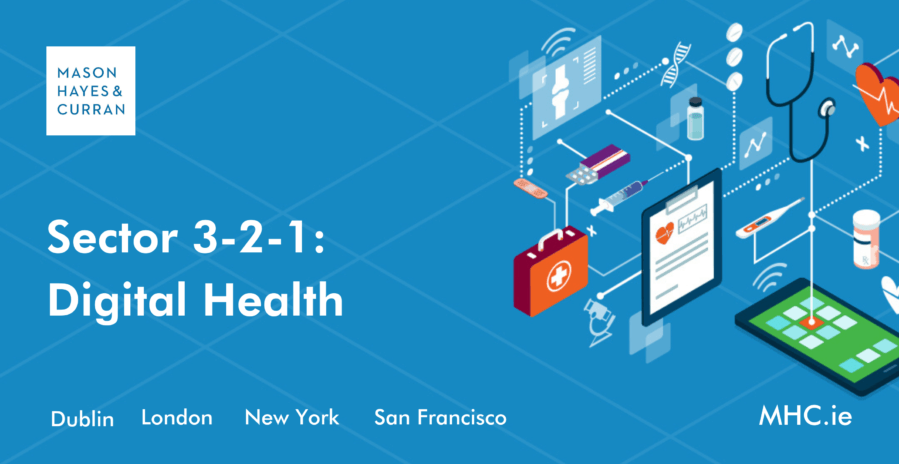
Although 2022 has made for a challenging year both macro-economically and politically, the EU digital health market has continued to mature as the demand for healthcare increases and the value offered by digital technologies gains greater recognition and acceptance amongst the clinical community and the public. We take time to reflect on three key developments in the sector over the last year, two emerging areas to keep an eye on, and one key insight for 2023.
Three important developments in 2022
1. Coming into effect of the IVDR
On 26 May 2022, the In-Vitro Diagnostic Regulation (IVDR) became fully applicable in the EU. The IVDR overhauls the previous regulatory regime in respect of in-vitro diagnostic devices (IVDs) provided for by the now repealed IVD Directive (IVDD) and represents a seismic shift for manufacturers with devices on the market in the EU.
Revised device classification rules contained in the IVDR have led to a surge in demand for conformity assessment services provided by notified bodies. Under the IVDD, approximately 20% of IVDs required conformity assessment in order to be legally placed on the EU market. Under the IVDR, that figure has shifted closer to 80%. Meanwhile, enhanced accreditation requirements that notified bodies must meet in order to be able to provide these services have resulted in a significant drop in notified body capacity, with only 8 notified bodies accredited under the IVDR at the time of writing.
Although the IVDR provides for a transitional period to allow manufacturers to transition their portfolios to the IVDR, notified body capacity has become a pressing structural obstacle for industry. With an EU Commission proposal for the extension of similar periods provided for in the Medical Device Regulation (MDR) having been recently tabled in response to similar challenges in the medical device sector, calls for similar arrangements in respect of IVDs are expected to grow throughout 2023.
Read More: The IVDR – What Now?
2. Publication of proposals for a revised Product Liability Directive and a draft Artificial Intelligence Liability Directive
The Product Liability Directive (PLD) has been in place for nearly 40 years and has provided an effective compensation mechanism for damage caused by defective products, but technological advances have led to the creation of a new generation of products that challenge some of its core rules and concepts. The proposal for a revised PLD seeks to address these challenges and provide the EU with a product liability regime fit to deal with the 21st century product landscape.
At the same time, AI adoption continues to accelerate across the EU. However, civil liability rules in respect of damage caused by AI systems are also underdeveloped. A proposal for an EU Artificial Intelligence Liability Directive aims to complement the revised Product Liability Directive by harmonising certain aspects of fault-based civil liability frameworks as they apply to AI systems.
- The Proposal for a Revised EU Product Liability Directive
- Regulatory Snapshot: the EU AI Liability Directive
3. Extension of MDR transition deadlines
With a surge in demand and limited notified body capacity, calls for an extension to the transition period provided for in Article 120 of the MDR have been growing steadily throughout 2022. To relieve pressure on both manufacturers and notified bodies with the ultimate aim of avoiding essential medical devices being taken off the EU market, the European Commission has now proposed a set of extensions to the transitional period.
Read More: Regulatory Snapshot: MDR transition timelines to be extended
Two important developments for 2023
1. Continued growth in the adoption of telemedicine and telehealth tools
Throughout 2022, and despite a general downturn in digital health funding and valuations, we have witnessed continued growth and activity in this area. We expect this trend to continue throughout 2023 as adoption amongst national health services and insurers accelerates, and the safety and value of remote care continues to be demonstrated, especially for certain groups such as elderly patients and those suffering from chronic conditions. Laws and regulations governing the provision of telemedicine services differ across EU Member States and can involve overlapping regulatory issues regarding dispensing and delivering medications for instance. However, these business models are here to stay and pressure for regulatory certainty and harmonisation amongst stakeholders operating in this area is expected to increase.
2. Continued growth in the use of wearables
We expect to see continued growth in the use of wearable devices to provide healthcare for a number of reasons. Firstly, wearable devices have an important role to play in the transition to more proactive and prophylactic models of healthcare by leveraging individuals’ health data to facilitate healthier behaviours and earlier pre-hospital healthcare interventions. Secondly, by providing a direct link to the individual patient in real time, wearable devices will be at the heart of a coming AI revolution in healthcare that has the potential to radically improve patients’ lives. Finally, wearable devices are also a clearly visible and readily available platform for ongoing collaborations and partnerships between the healthcare and technology sectors. In 2023, we anticipate an increase in high profile partnerships between manufacturers of consumer-oriented wearable devices and developers of medical device software and digital health platforms.
One key takeaway
AI in Healthcare
With the final wording of a text of an EU Artificial Intelligence Act drawing closer to agreement and adoption, and the recent publication of a draft AI Liability Directive, 2023 has the potential to be a pivotal year for the regulation of AI across the EU and globally. This is particularly relevant for digital health businesses, given that the focus of this new EU regime is undoubtedly on those AI systems which are ‘high-risk’, a category that is expected to include AI systems that are products, or are intended for use as safety components of products, covered by the MDR and the IVDR. The adoption of an AI Act has the potential to present a series of new challenges for the digital health sector given the possible requirement to demonstrate compliance with a complex regulatory framework that would sit alongside that provided for by the MDR and the IVDR. As suggested in our previous article, stakeholders can prepare by:
- Identifying and reviewing the AI systems that they currently use to assess how they may be regulated under the incoming AI regulatory regime
- Considering how existing regulatory functions and compliance systems can be modified to accommodate new AI requirements
- Where necessary, beginning to plan and develop possible new AI compliance strategies and systems using the general framework laid out in the Proposal
Read More: Regulating AI in the EU – What’s New
For more information, please contact a member of Product Regulatory and Liability team.
The content of this article is provided for information purposes only and does not constitute legal or other advice.





